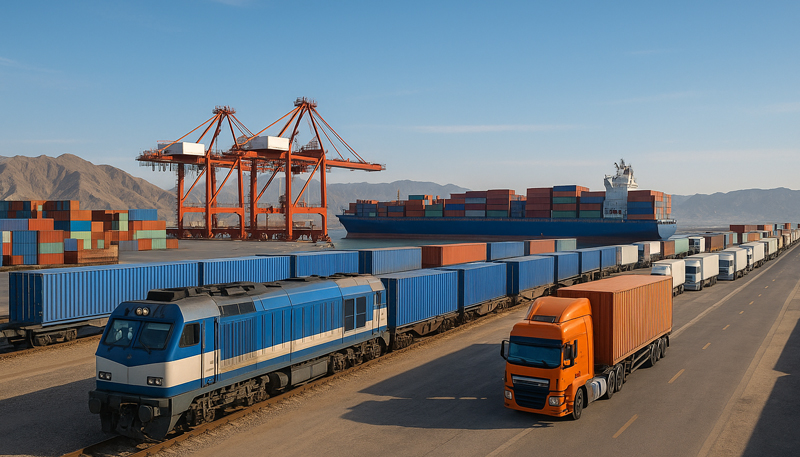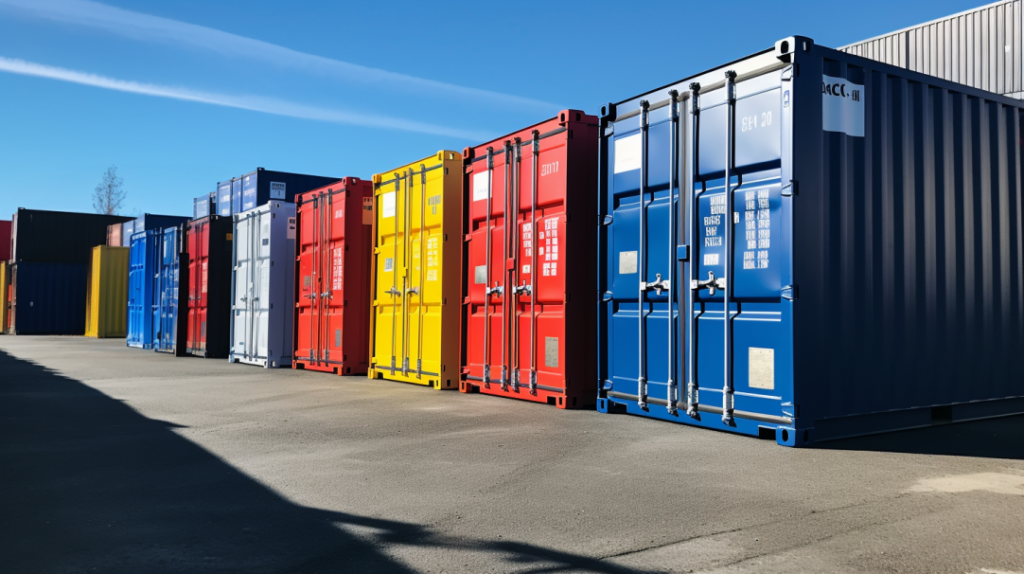Iran as a Logistics Bridge: Connecting the Persian Gulf to Central Asia and Europe

Executive Summary
Iran’s geographical location at the heart of Eurasia presents a unique opportunity for it to serve as a vital logistics bridge connecting the Persian Gulf to Central Asia and Europe. Its proximity to key waterways like the Persian Gulf and the Caspian Sea, coupled with its extensive land borders with several strategically important countries, positions Iran as a potentially advantageous route for international trade. The country possesses a developing transportation infrastructure comprising rail, road, and port networks, all of which are undergoing modernization and expansion. Iran’s involvement in major international transport corridors such as the International North-South Transport Corridor (INSTC) and the Belt and Road Initiative (BRI) further underscores its potential as a key transit hub. Realizing this potential holds significant economic benefits for Iran, including increased revenue from transit fees and a strengthened role in global trade. However, Iran faces considerable challenges in fully realizing its ambition, including infrastructure limitations, the impact of international sanctions, and geopolitical complexities within the region. Addressing these challenges through continued investment in infrastructure, strategic international agreements, and navigating the geopolitical landscape will be crucial for Iran to effectively function as a prominent logistics bridge in Eurasia.
Introduction
In the evolving landscape of global trade, the demand for efficient and shorter transportation routes has become increasingly critical, particularly within the Eurasian region. Iran occupies a uniquely strategic geographical position that inherently positions it as a vital link connecting the resource-rich regions of the Middle East and Central Asia with the burgeoning markets of South Asia and Europe. Bordering the Caspian Sea to the north and the Persian Gulf to the south, Iran serves as a natural land bridge, offering a potentially more economical and time-efficient route for cargo transit compared to traditional maritime routes. This report aims to provide a comprehensive analysis of Iran’s current and potential role as a key logistics bridge in Eurasia, examining its infrastructure, involvement in international transport corridors, economic and geopolitical implications, existing challenges, and future prospects in facilitating trade flows between these critical regions.
Iran’s Strategic Geographical Location
Iran’s geographical centrality within Eurasia is a fundamental asset that underpins its potential as a significant logistics hub. Situated at the heart of the International North-South Transport Corridor (INSTC), Iran’s location offers a crucial trade route connecting Russia, India, and Europe. Its proximity to the Persian Gulf, the Caspian Sea, and key land routes makes it an ideal hub for transit between East and West. This location presents a shorter and potentially more cost-effective route for businesses involved in transporting goods from Central Asia to Europe or shipping products from China to the Gulf States, especially benefiting landlocked countries such as Turkmenistan, Uzbekistan, and Azerbaijan. Iran also shares extensive land borders with key countries such as Turkey, Pakistan, Afghanistan, and Iraq, making it a crucial point for multimodal cargo movement. This geographical advantage allows for the integration of various transportation modes, including road, rail, and sea, to create efficient and seamless transit routes.
Iran’s historical role as a central node on the Silk Road further emphasizes its long-standing significance as a trade connector. For millennia, the Silk Roads facilitated the exchange of goods, ideas, and cultures between the East and the West, with Iran playing a pivotal role in this network. The ancient Persian Royal Road, built around 500 BC, traversed the heart of the Silk Road, connecting regions north of modern-day Iran into Central Asia and modern-day Turkey. This historical precedent demonstrates Iran’s inherent understanding of the dynamics of international trade and the infrastructure required to support it. The resurgence of these historical routes through modern initiatives like the BRI aims to revive these ancient connections, further highlighting Iran’s potential to serve as a crucial link in contemporary global trade.4 Iran’s strategic location, therefore, is not merely a modern phenomenon but is deeply rooted in centuries of its role as a vital artery in global commerce.
Transportation Infrastructure in Iran
Rail Network
Iran possesses a significant railway network that plays a crucial role in its transportation infrastructure, although it faces certain capacity limitations. The network, operated by the Islamic Republic of Iran Railways (RAI), spans over 12,998 kilometers of line and includes 360 stations. While most of this network uses the standard gauge, there are sections with Russian and Indian gauges to facilitate connections with neighboring countries. The railway system currently handles a substantial volume of freight, with approximately 33 million tonnes of goods transported annually. However, the productivity of Iran’s rail transport network is less than one-third of the global average, indicating room for significant improvement. A considerable portion of the railway lines consists of single-track railways, which severely hampers traffic flow and reduces efficiency. Additionally, the electrification rate of the railway network remains low, further impacting its operational speed and capacity.
Recognizing the vital role of rail in modern logistics, Iran has embarked on ambitious development projects aimed at expanding and modernizing its railway infrastructure. One of the key projects is the Rasht-Astara railway, a crucial missing link in the INSTC that will enable seamless cargo transit between Iran, Azerbaijan, and Russia. Despite agreements dating back to 2005, this project has faced delays, but recent developments indicate renewed commitment to its completion. Another strategically important project is the Chabahar-Zahedan railway, which aims to enhance connectivity to Central Asia and beyond by linking the port of Chabahar on the Sea of Oman to Iran’s national rail network. Construction on this line has been underway since 2020, with plans to eventually extend it to Afghanistan. Iran also has ambitious plans to build nine strategic rail corridors spanning 17,000 kilometers, contingent upon securing €10 billion in funding. These corridors aim to increase the nation’s freight capacity to 60 million tons annually and connect vital ports and economic centers across the country. Furthermore, there are ongoing initiatives to electrify and double-track existing railway lines, such as the busy Tehran-Mashhad line, to increase speed, capacity, and efficiency. These significant investments and development plans demonstrate a strong commitment to enhancing Iran’s railway sector and its role in facilitating international transit. Companies such as Arta Rail have aligned their service expansion strategies with Iran’s evolving rail infrastructure, focusing on optimizing cross-border transit and supporting freight flows along critical north–south corridors.
Road Network
Iran boasts a well-developed road network that serves as a critical component of its transportation infrastructure, facilitating both domestic and international freight movement. Spanning over 220,000 kilometers, this network includes highways and expressways that connect major cities, towns, and rural areas, extending to neighboring countries such as Turkey, Iraq, Afghanistan, and Pakistan. Major highways like the North-South Transport Corridor, connecting the Caspian Sea to the Persian Gulf, and the East-West Transport Corridor, linking the border with Turkey to the border with Afghanistan, play a vital role in regional trade. The road network supports the movement of various types of vehicles, including passenger cars, buses, trucks, and cargo transport, across the country. This extensive network has been instrumental in establishing Iran as a crucial transit corridor for goods flowing from Central Asia, Russia, and Europe to the Indian Ocean and vice versa.
Despite its extensive reach, a considerable portion of Iran’s road network requires ongoing maintenance and modernization, particularly in rural and mountainous regions. The quality and capacity of roads significantly impact the efficiency of cargo transit, and efforts are continuously being made to upgrade and expand the network. The Tehran-Istanbul route, for instance, stands out as a significant artery for goods moving between the Middle East and Europe, highlighting the importance of well-maintained international road connections. Furthermore, Iran’s road network forms crucial corridors that participate in international transit routes, most notably the INSTC, providing essential links with neighboring countries in Central Asia and beyond. The government has also been actively working on expanding the freeway network, with projects like the Tehran-Shomal Freeway aiming to improve connectivity and reduce traffic bottlenecks. The continuous development and maintenance of its road infrastructure are essential for Iran to effectively serve as a reliable logistics bridge in the region.

Iran’s Role in Key International Transit Corridors
International North-South Transport Corridor (INSTC)
Iran’s strategic geographical location places it at the heart of the INSTC, a crucial multimodal trade route connecting India, Iran, Russia, Central Asia, and Europe. Established in 2000 by India, Iran, and Russia, the INSTC aims to reduce transit costs and time compared to traditional routes like the Suez Canal. Iran’s robust infrastructure and ongoing investments make it a central player in the INSTC’s success, offering the shortest freight transport link between the EAEU, South Asia, East Africa, and the Far East. The corridor utilizes a network of ships, railways, and roads to link major economic regions, with Iran serving as a critical land bridge connecting the Persian Gulf to the Caspian Sea and onward to Russia and Europe. With operational insight into regional dynamics, Arta Rail has been actively involved in enabling multimodal cargo movement across key INSTC segments, particularly those connecting southern ports to northern borders. Key Iranian ports like Bandar Abbas and Chabahar on the Persian Gulf, and Bandar-e Anzali and Amirabad on the Caspian Sea, are integral to the INSTC, facilitating the movement of goods between these regions. Iran is also heavily investing in railway infrastructure along the INSTC, including the crucial Rasht-Astara railway, to enhance connectivity and eliminate bottlenecks. The completion of this missing link will enable seamless cargo transit between Iran, Azerbaijan, and Russia, further solidifying Iran’s role in the corridor. Despite facing challenges such as incomplete infrastructure and geopolitical tensions, the INSTC holds immense potential to strengthen Eurasian connectivity and foster economic integration among participating nations, with Iran playing a pivotal role in realizing this potential.
If your supply chain strategy involves leveraging the International North-South Transport Corridor (INSTC) or other emerging freight corridors through Iran, Arta Rail’s logistics specialists can support you with expert route planning, transit time analysis, and tailored rail-based solutions that fit your operational goals. Submit a request to start the consultation process with our team.
Belt and Road Initiative (BRI)
Iran’s strategic location also positions it as a significant country within China’s ambitious Belt and Road Initiative (BRI), aimed at enhancing connectivity and trade across Asia, Europe, and Africa. Iran has been an important transportation hub and trade distribution center on the ancient Silk Road, making it a key partner for the BRI. In 2016, Iran and China signed a memorandum of understanding on the BRI cooperation, leading to steady advancements in bilateral cooperation. Several routes within the BRI pass through Iranian territory, including railway lines connecting China to Kazakhstan, Turkmenistan, and Iran, eventually reaching Europe. While some of these routes may not be the fastest, they offer crucial alternatives and enhance connectivity across the Eurasian landmass. China has also invested in infrastructure projects within Iran as part of the BRI, including financing for water, energy, and transport projects. The development of railway lines, such as the one connecting Urumqi in China to Tehran, has significantly reduced transportation times for goods moving between the two countries. Iran’s participation in the BRI is expected to further enhance its role as a key transit hub in Eurasia, facilitating the flow of goods and strengthening its economic ties with China and other participating nations.

Economic Implications of Iran’s Transit Role
Iran’s role as a logistics bridge holds significant economic implications for the country and the wider region. The development of efficient transit corridors like the INSTC and participation in initiatives like the BRI can generate substantial revenue for Iran through transit fees. Estimates suggest that Iran could potentially earn billions of dollars annually from transit if it fully realizes its capacity. This income could play a pivotal role in modernizing Iran’s logistics infrastructure and improving the country’s logistics service offerings, potentially even surpassing revenues from traditional oil exports. Arta Rail’s service portfolio is designed to capitalize on this potential, offering scalable logistics solutions that integrate rail, port, and road operations across Iran’s major economic corridors. The establishment of Iran as a key transit hub can also boost its non-oil exports by facilitating trade with neighboring countries and providing access to global markets for its products. The increased flow of goods through Iran can stimulate economic growth in various sectors, including transportation, warehousing, and related services, creating new employment opportunities and fostering regional economic integration. Furthermore, Iran’s strategic location offers cost-effective and time-efficient transit options, making it an attractive route for international businesses and potentially reducing overall transportation costs for goods moving between Asia and Europe. By capitalizing on its transit potential, Iran can strengthen its economic resilience, diversify its revenue streams, and enhance its position as a vital player in the global economy.
Geopolitical Implications of Iran’s Transit Role
Iran’s emergence as a major transit hub carries significant geopolitical implications, influencing its regional and international relations. By positioning itself as a key link between the Persian Gulf, Central Asia, and Europe, Iran can enhance its regional influence and leverage in negotiations with other global powers. Its central role in strategic corridors like the INSTC strengthens its ties with countries such as Russia, India, and Central Asian nations, fostering economic cooperation and potentially leading to new regional alliances. Iran’s transit position can also provide landlocked countries in the South Caucasus and Central Asia with a crucial alternative for trade, diversifying their access to global markets and reducing their reliance on traditional routes. The development of transit corridors can also serve Iran’s foreign policy objectives, helping it overcome international isolation by establishing closer trade and economic ties with regional states. However, Iran’s geopolitical ambitions in the transit sector also face challenges. Competition from alternative corridors, such as the Middle Corridor bypassing Russia and Iran, and geopolitical tensions within the region can hinder its progress. Additionally, Iran’s strained relations with some countries, including Israel and historical complexities with Turkey, could impact its ability to fully capitalize on its transit potential. Navigating these complex geopolitical dynamics while focusing on infrastructure development and fostering international cooperation will be essential for Iran to solidify its role as a major transit hub in Eurasia.
Existing Challenges and Obstacles for Iran as a Logistics Bridge
Despite its significant potential, Iran faces several challenges and obstacles in fully realizing its role as a prominent logistics bridge in Eurasia. Infrastructure limitations remain a key concern, with the railway network requiring substantial upgrades in terms of double-tracking, electrification, and overall efficiency. Similarly, while the road network is extensive, ongoing maintenance and modernization are crucial to ensure smooth and efficient cargo transit. International sanctions have also significantly impacted Iran’s logistics potential by limiting access to foreign investment, modern technologies, and participation in global trade networks. These sanctions complicate financing for infrastructure projects and deter international shipping companies from utilizing Iranian routes. Political interference and bureaucratic hurdles can further impede the development and operation of efficient transit corridors, leading to delays and increased costs. Moreover, Iran faces strong competition from other emerging transit corridors in the region, such as the Iraq-Turkey-Europe Development Road and routes through Azerbaijan and Central Asia, which are actively seeking to capture a share of the growing Eurasian trade. Overcoming these multifaceted challenges will require sustained efforts in infrastructure development, strategic international engagement to mitigate the impact of sanctions, and policy reforms to streamline transit procedures and enhance overall efficiency.
Conclusions
Iran possesses a unique and significant geographical advantage that positions it as a potential logistics bridge connecting the Persian Gulf to Central Asia and Europe. Its central location at the crossroads of major trade routes, coupled with ongoing efforts to modernize and expand its transportation infrastructure, offers a compelling alternative to traditional maritime routes. Iran’s active participation in key international transit corridors like the INSTC and BRI further underscores its strategic importance in facilitating Eurasian trade. Realizing its full potential as a logistics hub holds substantial economic benefits for Iran, including increased revenue, diversified trade opportunities, and enhanced regional influence. Companies like Arta Rail are well-positioned to support this transformation, leveraging years of experience in cross-border logistics and infrastructure-aligned service models.
However, Iran faces considerable challenges in achieving this vision. Infrastructure limitations, the persistent impact of international sanctions, and geopolitical complexities within the region continue to hinder its progress. Competition from other emerging transit corridors also presents a significant obstacle. To effectively function as a major logistics bridge, Iran needs to prioritize continued investment in modernizing its rail, road, and port infrastructure. Strategic international agreements and diplomatic efforts to mitigate the impact of sanctions will be crucial in attracting foreign investment and encouraging the use of Iranian transit routes. Furthermore, policy reforms aimed at streamlining customs procedures, reducing bureaucratic hurdles, and ensuring the security and reliability of transit will be essential in enhancing Iran’s competitiveness in the global logistics landscape. By addressing these challenges with a focused and comprehensive approach, Iran can solidify its role as a vital logistics link in Eurasia, contributing significantly to regional trade and its own economic prosperity.
